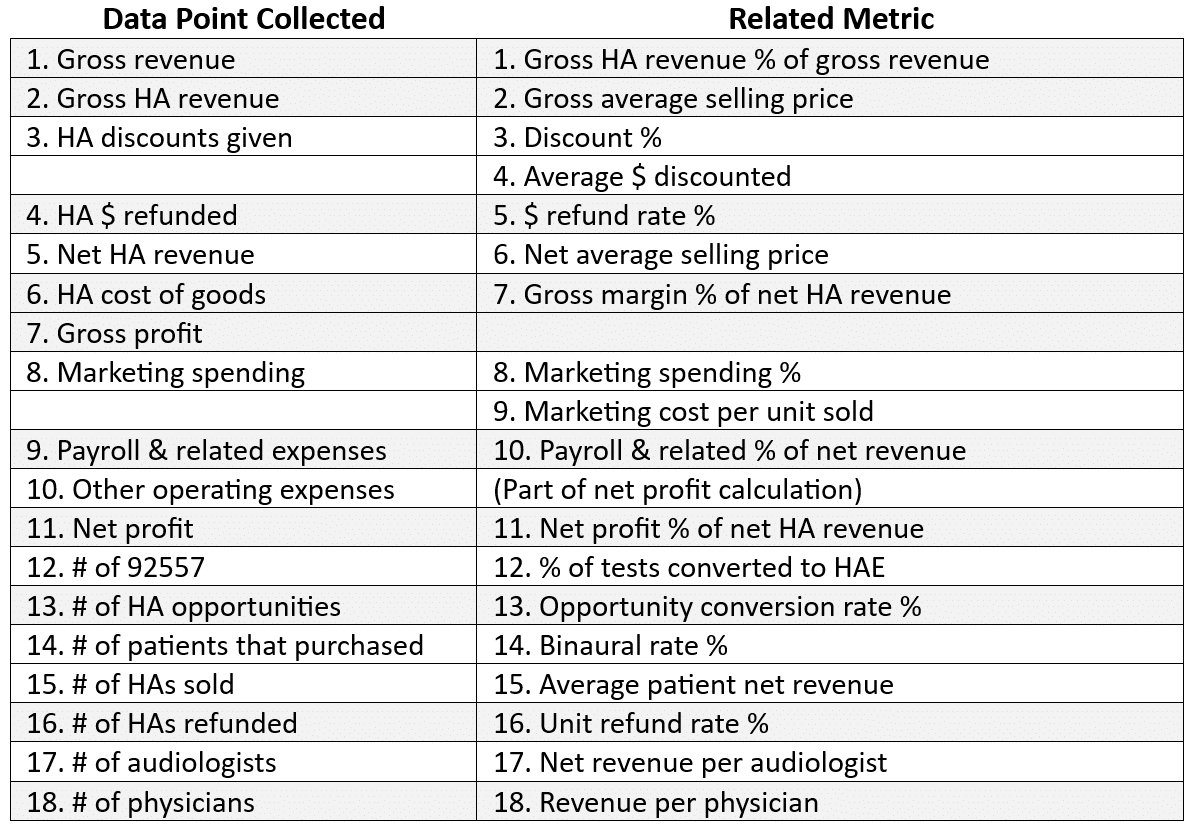Analyze Your Practice’s Operational and Financial Performance With KPIs
How do you decide if your practice needs a new marketing campaign, if you should hire another audiologist or if you should accept more or less third-party programs? These decisions aren’t easy and often require a monetary investment, so they need careful thought. Many people use their intuition to make decisions, which is a hit-or-miss method of decision-making. A better alternative is to make informed decisions by collecting and analyzing key performance indicators (KPIs). This Ask Fuel First section answers the question: How can KPIs help me make informed decisions about my practice?
Your Dashboard for Insight
Think about KPIs like a dashboard for your car. They alert you to potential pitfalls related to efficiency and performance and then point you in the right direction to address and improve the areas of greatest need. For example, just before your car runs out of oil, you’ll see a warning light on your car’s dashboard. Similarly, KPIs warn you that there’s a problem in a particular area of your business so that you can take steps to prevent the problem from occurring. Just like your car’s dashboard can’t warn you of every problem that might occur with the vehicle, KPIs can’t warn you of every problem. But KPIs can give you a fighting chance in case something unexpected happens.
You Can’t Manage What You Can’t Measure
As with any business, audiology and ENT practices manage sales, marketing, finances and employees. If you’re not addressing those aspects of the practice by measuring KPIs, you’re most likely guided by emotion or flying blind. Instead of considering what you think about an issue, look at what you know—the factual data and how it stacks up against benchmarks from other like-sized practices. Year-over-year or even month-to-month fluctuations in your business can make you nervous, so it’s important to lean into the data to be able to diagnose exactly what is causing your business to be ahead or behind the period you are comparing against. When you do that, you’ll be surprised how confident you become when making important decisions.
For example, you might wonder what impact third-party programs have on like-size practices. By looking at KPI data, like margin per patient or third-party percentage, and knowing where the benchmarks are for those KPIs, you can gauge how many more third-party patients it will take to generate the same cash flow as traditional hearing aid patients. This will help determine whether your providers have the capacity to generate enough cash flow on an annual basis to ensure the department is profitable. If your providers are unable to generate close to two times their total personnel costs because 30% or more of their patients are from third-party programs, reducing or moving away from third-party payors might be wise. But you won’t know that unless you look at the data (listen to Bryan Grant, Fuel Medical’s Director of Finance, discuss “Using KPIs to Make Business Decisions”).
18 Key Points
At Fuel Medical, we focus on data collected from 18 key metrics to identify target ranges for our members (see Table 1. Key KPI Metrics). When any of these metrics fall outside the desired scope, we diagnose the problem and offer solutions to impact your bottom line positively. These metrics are the “check oil” light for your practice, alerting you to potential problems. But KPIs aren’t just preventative; they are strategic. By analyzing the data collected, you can set goals for the entire practice or individual employees.
Table 1. Key KPI Metrics

Your Report
Data collected monthly is used to populate an easy-to-read “Executive Summary,” which visually captures your operational and financial performance. These reports can show how your business is doing monthly, year-to-date and year-over-year if you continue tracking these metrics long-term.
You’ll also see how your practice stacks up to others. Fuel Medical collects anonymous data from all types of practices nationwide, including single-specialty, multi-specialty, university clinics and nonprofit organizations. We display the data from each metric in three benchmark tiers: the lowest, mid-range and the highest. Seeing where your practice falls within these categories with like practices gives you a new perspective on how your business is doing. But this is only part of what KPIs can do for you. Curious how your practice measures versus your peers? Complete the form fill on the right side of this page to obtain your copy of our KPI benchmarks.
Creating Smart Goals
KPIs are the foundation on which goals are established. Once the data is collected, your Fuel Medical regional team can help you analyze it. We’ll look at each metric point to see areas where your practice excels and areas performing less than expected. Because we work with practices nationwide, our regional teams know what specific data patterns indicate.
Imagine the following scenario: It seems that you have too many empty appointment slots, so you decide that the solution is to create a marketing campaign to bring in new patients. You spend $10,000 on a comprehensive campaign sending prospect mailers to targeted people. After six months, you notice that some new patients have come in, but many empty appointment slots remain. You’re frustrated because the expensive marketing campaign hasn’t solved your problem.
Scenarios like this are playing out nationwide, but they don’t have to. By tracking KPIs, audiology and ENT practices can solve problems like the one described above by analyzing the data. With the correct information, this administrator might notice that the practice has enough patients being scheduled for hearing tests as each provider’s appointment volume is between the median and top 20% benchmark. When the administrator looks at the conversion of hearing tests to opportunities (HAEs or CNAs), there is a significant drop in the number of HAEs or CNAs being scheduled. This indicates that there are patients slipping through the cracks after they have their hearing test. Now, the administrator knows that the issue isn’t with the marketing campaign, but rather there’s an opportunity to plug some holes internally to reduce the number of patients not scheduling their hearing aid evaluation appointment after their hearing test indicates they could benefit from hearing aids. This solution won’t cost you any money other than the time it takes to pull appointment data by audiologist and analyze it against benchmarks. Every hearing aid patient opportunity lost costs the practice about $2,500, so it is well worth the time to go through this exercise.
KPIs can be confusing, so many people avoid using them in their practices. But you aren’t alone. Fuel Medical can help you with this process. We’ll explain which data needs to be collected, review it at specific intervals throughout a year, discuss areas of strengths and weaknesses that appear through that analysis and then recommend improvement plans to keep your practice running smoothly and profitably. Fill out the form fill on this page to learn more and get your copy of our KPI benchmarks.
